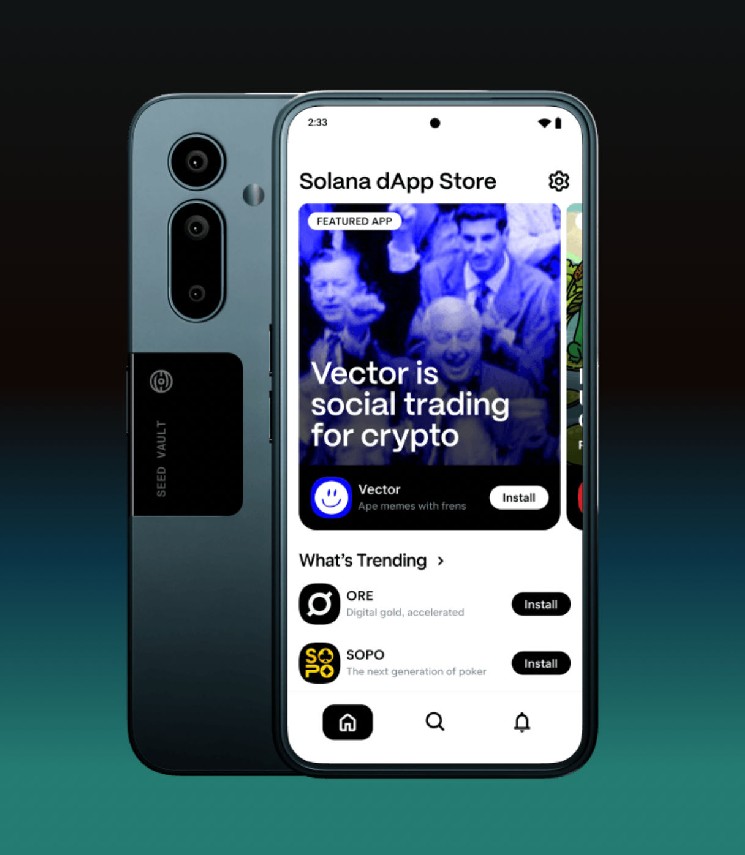Solana has evolved from being just a protocol to something you can hold, wear, tap, and live with. It is moving beyond on-chain assets to a growing ecosystem of real-world hardware.
—
From smartphones and health rings to hotspot nodes and self-custodial debit cards, this is more than just a product expansion. This is a strategic attempt to turn Solana into the first blockchain with a complete physical stack.
This change has a significant impact on your users’ Web3 experience. While other chains focus on L2 throughput and modular architecture, Solana is answering a different question. What if blockchain was in your pocket, on your wrist, or on your doorstep?
The Seeker Phone: Mobile Onboarding Tool for Web3
Solana Mobile’s new device, the Seeker, is the successor to the original Saga phone and offers a sleeker, lighter, and more affordable option. Seeker ships worldwide and is equipped with a 6.36-inch AMOLED display, MediaTek Dimensity 7300 chip, and 8GB RAM. More important than the specs is what’s inside the OS. Each phone includes Seed Vault, Solana’s unified private key management tool, which stores keys in a secure enclave so users can sign transactions without exposing sensitive data.
Unlike most Android smartphones, this one does not treat cryptocurrencies as an app layer. Incorporate Web3 at the operating system level. Each device will also be assigned a unique Genesis Token (a non-transferable NFT) that acts as a built-in ID pass and loyalty credential. Solana Mobile says this will open up access to perks, gated content, and future airdrops.
By building phones that don’t just run Web3 apps, but are designed around them, Solana is creating a dedicated entry point for a new class of users who expect their devices to be as native to cryptocurrencies as they are to social and payments.
Helium and mobile SIM devices
Solana is also becoming the backbone for wireless access through Helium Mobile, which has deployed SIM cards and hotspot nodes running on Solana. These devices allow users to earn tokens by contributing to wireless coverage. This is a physical extension of the DePIN movement, turning everyday devices into passive income sources.
Rather than simply earning tokens, these hotspot devices contribute to a broader decentralized mesh network that provides real-world coverage to users in exchange for crypto rewards. This turns the communication model upside down. Helium allows communities to own and operate their own wireless zones instead of relying on centralized infrastructure. This model enables grassroots participation in one of the most expensive and centralized industries: connectivity itself, whether in response to urban overcrowding or rural inequality.
Solana gaming devices unlock new possibilities
A gaming console designed specifically for the Solana ecosystem. The device reportedly includes an octa-core ARM processor, 8GB RAM, 128GB storage, WiFi 6 and Bluetooth 5.4 connectivity, and built-in hardware wallet functionality with the SvalGuard security system.
It’s designed to not only play games, but also house on-chain assets, allowing players to manage their tokens and NFTs directly from the console, essentially combining gaming and cryptocurrency storage in one device. This is more than just a gaming device. This shows that Solana is betting on entertainment as the gateway to mass adoption of cryptocurrencies, embedding digital ownership directly into the gaming experience without requiring users to touch a browser or DEX.
Ledger Flex for Solana: Cold Storage with Ecosystem DNA
Security is at the core of any cryptocurrency experience, and Solana has a custom hardware wallet to match. Ledger Flex Solana Edition takes the widely trusted Flex device and adds Solana-specific branding, SPL token support, and Soulbound tokens for identity. It also integrates with Solana native applications out of the box.
Ledger’s team confirmed that the device is designed for long-term users who want secure offline access without sacrificing ecosystem compatibility. This is part of a broader strategy to extend Solana’s identity into everyday tools, effectively turning cold storage into another point of connection with the community.
CUDIS rings and DePIN devices (wear-and-deploy infrastructure)
Beyond user-facing gadgets, Solana is moving into physical infrastructure. This includes health-focused wearables and decentralized hotspots. One standout project is CUDIS Ring, a smart health ring that tracks activity, rewards movement, and links biometric data to on-chain incentives. Unlike mainstream fitness trackers that collect data on corporate servers, CUDIS allows users to monetize their metrics and maintain control of their information. Its architecture runs directly on Solana and leverages the on-chain token economy to reward engagement.
Solfrea Card (Easy self-managed spending)
Solflare’s new debit card offers users a way to spend USDC directly from their wallets without relying on a custodial account. This marks a shift from regular prepaid crypto cards, which typically require users to deposit assets into a managed account before they can be used to make purchases.
With Solflare, your balance remains in your wallet until the moment you swipe. Integrations with Mastercard, Google Pay, and Apple Pay allow you to do this worldwide. The Solflare team is calling this Solana’s first true self-custodial crypto card, and it does so by eliminating the extra steps that traditionally separate crypto balances from real-world utility.
Stack, not just a chain
Devices such as Seeker phones, Ledger Flex, CUDIS rings, hotspot nodes, and Solflare cards do more than just solve narrow use cases. Together, they form a vertically integrated hardware stack that connects directly to the Solana network. It’s no longer just about writing to the blockchain. Now, it’s about living with it.
This is important because it changes the adoption curve. Rather than convincing users to download yet another extension or purchase another governance token, Solana provides functional tools out of the box. And by connecting all your devices to the same on-chain identity and wallet infrastructure.
Solana has high retention rates by design. Users onboarded through Seeker smartphones, paying with Solflare cards, earning at hotspots, and storing their keys on Ledger are deeply tied to the ecosystem, meaning they are much less likely to jump to another chain.
Other networks focus on horizontal scaling, distributing infrastructure across rollups and sidechains. In contrast, Solana is going vertical, embedding its protocols into hardware, identity, payments, and infrastructure.
final thoughts
Hardware is not an easy game. Manufacturing takes capital. Distribution requires logistics. Also, user behavior can be difficult to predict. But the advantage here is clear. If Solana’s physical expansion goes well, it will become the first blockchain with a truly embodied presence. It will go beyond apps and tokens and permeate the world of objects and daily life.
This is not just about the convenience of cryptocurrencies. It’s about rethinking the relationship between users and the networks they rely on. When your phone is your wallet, your router is your node, and your ring is your reward-earning sensor, cryptocurrencies cease to be an abstract concept and become part of your everyday life.
Solana’s bet is that true adoption will occur when blockchain stops asking users to access it and instead shows up in the tools users already use.






